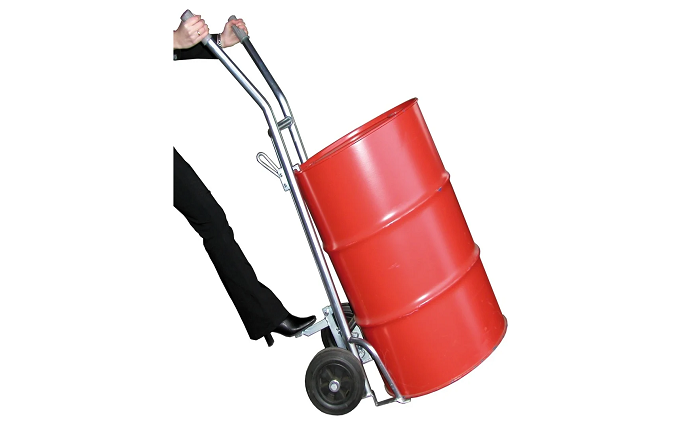
In the industrial world, efficient material handling is critical to operational success. One piece of equipment that plays an understated yet vital role in many businesses is the drum trolley—a simple, wheeled device designed for the safe transport of heavy drums and barrels. These trolleys are an indispensable solution for companies managing bulk liquids, powders, or chemicals stored in 200-liter (55-gallon) drums. From improving workplace safety to increasing productivity, drum trolleys streamline transport processes across various sectors.
This article explores how drum trolleys are used in business transport operations, why they matter, and what considerations businesses should keep in mind when implementing them into daily operations.
The Role of Drum Trolleys in Business Transport
Drum trolleys serve a specific but crucial function: they allow workers to move heavy, cumbersome drums without lifting or excessive strain. These drums, when filled, can weigh over 200 kilograms (about 440 pounds), making manual handling both difficult and dangerous.
In many businesses, particularly those in manufacturing, chemicals, food processing, or oil and gas, transporting drums is a daily task. Drum trolleys allow employees to move these items safely, efficiently, and with minimal physical exertion, reducing the risk of injury while speeding up workflow.
Key Advantages of Using Drum Trolleys in Business
1. Improved Safety
One of the main advantages of drum trolleys is the reduction in workplace injuries. Lifting or rolling drums manually can lead to back injuries, strains, and accidents. Drum trolleys eliminate the need for direct manual handling, providing ergonomic support and reducing the physical toll on workers.
Some models even include features like drum clamps, tilt mechanisms, and hydraulic lifts, allowing workers to not only transport but also position, pour, or empty drums safely.
2. Enhanced Productivity
Time is money in the business world, and drum trolleys can significantly reduce the time it takes to move large containers across a facility. Instead of using forklifts or relying on teams of workers to reposition drums, a single worker can use a trolley to move a drum quickly and efficiently. This improves workflow continuity and allows employees to focus on more critical tasks.
3. Versatility in Material Handling
Drum trolleys are not limited to one type of product or drum. They can be used for:
- Steel or plastic drums
- Open-head or closed-head drums
- 30 to 55-gallon capacities
- Liquids, powders, or semi-solids
This makes them a versatile tool across industries, adapting to multiple transport needs. The convenient multipurpose drum trolley is designed to handle a wide variety of drums and materials, making it an essential piece of equipment in many business environments.
4. Cost-Effectiveness
Compared to more complex material handling systems, drum trolleys are relatively inexpensive. They have low maintenance costs, and their long service life ensures a strong return on investment. Furthermore, by reducing injury risks, businesses save on potential compensation claims and absenteeism.
Common Business Use Cases
Drum trolleys are essential in any environment where drums are stored, transported, or emptied regularly. Here are several industries where they shine:
Manufacturing Facilities
In factories, lubricants, cleaning solutions, or other liquids are often stored in drums. Trolleys help move these materials between workstations or to and from storage, supporting lean and just-in-time manufacturing processes.
Chemical Plants
Chemical drums require cautious handling due to the hazardous nature of their contents. Drum trolleys designed for chemical resistance ensure that transport is both safe and compliant with environmental and safety regulations.
Warehousing and Logistics
Drum trolleys are used to load and unload transport vehicles or to rearrange stock in large warehouses. In distribution centers, they support the efficient flow of materials without interrupting operations.
Food and Beverage Industry
In production kitchens or beverage factories, ingredients like syrup, oil, or cleaning agents are stored in bulk. Stainless steel drum trolleys ensure hygienic, non-corrosive transport, suitable for food-grade environments.
Oil and Gas Sector
From lubricant drums to fuel containers, the oil and gas industry heavily relies on mobile, rugged trolleys to maneuver drums across refineries, workshops, and field locations.
Key Features to Consider
Businesses investing in drum trolleys should consider several factors to match the right equipment to their needs:
- Weight Capacity: Standard drum trolleys handle 200- to 300-kg drums, but heavy-duty models exist for larger or denser contents.
- Wheel Type: Pneumatic tires are ideal for uneven surfaces, while solid rubber or polyurethane wheels work best on smooth floors.
- Material: Steel trolleys are durable and affordable, while stainless steel is recommended for clean or corrosive environments.
- Tilt and Pour Options: Some trolleys include mechanisms to allow easy decanting of liquids without lifting the drum off the trolley.
- Safety Features: Look for brake locks, containment trays, or anti-slip surfaces when working with hazardous or spill-prone materials.
Compliance and Workplace Standards
Using drum trolleys can help businesses comply with occupational health and safety (OHS) regulations. In many regions, manual lifting of heavy objects is restricted, especially when mechanical alternatives are available. Employing drum trolleys demonstrates an employer’s commitment to workplace safety and can protect the company from legal liabilities.
Trolleys used in industries dealing with flammable or hazardous materials may need to meet specific certifications, such as ATEX compliance for explosive environments or FDA compliance for food-grade materials.
Environmental and Sustainability Considerations
Drum trolleys also contribute to a more sustainable business model. By improving handling efficiency, they reduce the likelihood of spills or product waste. Well-designed drum trolleys can integrate into closed-loop systems where containers are reused and refilled, reducing packaging waste.
Furthermore, manual trolleys (non-motorized) consume no energy and can often replace forklifts for short-distance transport—lowering a facility’s carbon footprint.
Conclusion: A Small Tool with Big Impact
In summary, drum trolleys may appear simple, but their role in industrial transport is anything but minor. By improving safety, increasing productivity, and reducing costs, these devices are invaluable to a wide range of businesses. From warehouse logistics to chemical processing, drum trolleys enable efficient and safe material handling while aligning with broader goals of operational excellence and compliance.
As businesses strive for smarter, safer workflows, the humble drum trolley proves that the right tool doesn’t have to be complex to be effective. Instead, it just has to solve a real problem—efficiently and reliably, day in and day out.



